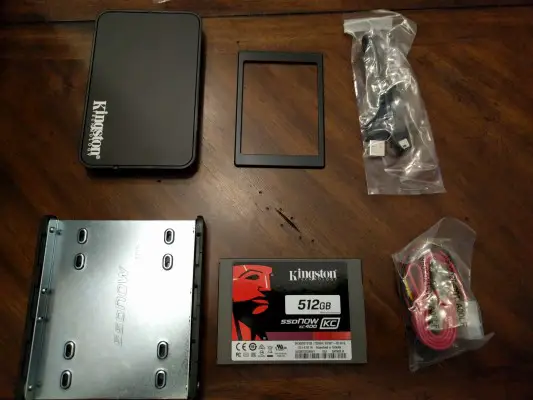As you know from my review for it, I selected an MSI Z170A Gaming M7 motherboard for my most recent upgrade. One of the most attractive options was the bleeding-edge next-generation storage options, courtesy of a new M.2 drive interface. This new connector is, on paper, capable of 32Gbps throughput, compared to the standard 6Gbps via SATA III connectors. I’d need an M.2 drive to test that theory.
Looking through a lot of manufacturer options, I went with a trusted storage company I have used for a very long time — Kingston, and their HyperX line. They’ve been manufacturing memory and drives since 1987, and I’ve used everything from their mechanical drives to their thumbdrives without a problem. Their HyperX Predator line of M.2 drives (hereafter referred to simply as Predator) were an easy choice.
Predator M.2 drives come in two sizes, and with or without a PCIe adapter. For just 10 bucks extra, this kit’s included adapter offers up some additional flexibility for older systems, or if your favorite new motherboard doesn’t have an integrated M.2 PCIe socket. If your motherboard supports it without an adapter, that manufacturer is sure to crow about it at length on the back of the product’s box.
Before we get into any measurements, it’s important to understand that 6Gbps does not mean six gigabytes per second — it’s shorthand for six gigabits per second, which translates to 750 megabytes per second. Megabytes per second (abbreviated as MB/s) is what you’ll see when you transfer things in Windows, so it’s the more real-world recognizable metric. The two nomenclatures are not interchangeable, and you have to be careful with product descriptions as they spend a great deal of time talking about what is theoretically possible, rather than what real-world application will bring.
The MSI A170 Gaming M7 I chose for my most recent build supports two M.2 drives, their sockets nestled right in between the PCIe slots. M.2 drives come in two different lengths (they are different than MSATA and incompatible, though they look similar). These lengths allow the Predator to pack in more NAND Flash Chips (A19 flash from Toshiba, if you want the details), granting additional drive capacities. The shorter ones (designated as 2230 and 2242, for reference) are smaller, sporting up to three chips, but the Predator series uses a longer form factor (the 22110 and 2280 form factors) can have up to 8 NAND chips to push upwards of 1TB of drive space. The smaller form factors are often used in higher end laptops to conserve space, whereas desktop replacements (like my OriginPC laptop — you can read that review here) uses the full-length form factors.
Much like when the SSD market was beginning, this new form factor is more expensive than its predecessors. Mechanical drives are pushing towards the 10TB mark using drives filled with helium, and SSDs about to pass the 2TB line. The M.2 line come in 240GB and 480GB drive sizes. A quick price check at the time of writing shows the 240GB (with adapter) coming in at $189 on Amazon, its larger brother being predictably at $389 at Amazon as well. A quick bit of math shows the average cost for a mechanical drive is about 3 cents per gigabyte, and SSDs coming in around 37 cents per gig. These M.2 drives are at a bit of a premium at 81 cents per gigabyte. Why would anyone pay that much extra?
Speed, glorious speed.
Before we get into benchmarking, you might need a bit of a lesson on drive technologies. There are several variants of the SATA bus but the current technology is referred to as SATA III. (you might recall a marked increase in speed moving from the internal SATA II drives of the XBox One to the external SATA III hard drive in my OWC Xbox One Upgrade Kit review) SATA III tops out at 6Gbps, but that doesn’t mean you’ll actually transfer six gigs every second. No matter how hard we try, however, we can’t break the laws of physics. Mechanical drives have a maximum rotational speed, and even the Enterprise-level drives running at 15,000 rpm still can’t hit those numbers. In reality, the best you’ll probably ever see is roughly 180MB/s, with reality giving us transfer speeds around 80 to 90MB/s. There are other technologies that can queue and buffer to push read and write speeds, but that’s a game of inches, not miles. SSDs use the same technologies, eliminating the mechanical component, but still bound by their cable shackles. SSDs don’t have the spin-up/spin-down disadvantages, so their read and write speeds are ready immediately instead of having to ‘spin up’.
Like all electronics, there are wide variances between a consumer version and an enterprise version of things. Consumer SSDs can reliably push more than 200MB/s. Extremely expensive enterprise versions of these same SSDs are capable of pushing that to 600MB/s.
M.2 drives can theoretically push more than double that speed, but I’d have to test that theory.
With a direct integration into the board, the theoretical speeds you’ll see on the back of the box is 32GBps. But we’ve already talked about that theoretical nonsense, haven’t we? I wanted to use it the way normal people would and showcase the real world results. I had a few games in mind — ones that were heavy on streaming, had longer load times, or simply were so large that copying them to and from would showcase the capability of the Predator drive. The easy choice for me was our Game of the Year for 2015 — The Witcher 3: Wild Hunt.
The Witcher 3’s file size, with all of its available DLC and the first expansion pack weighs in at 29 GB. Before I shoved that much across the bus of my motherboard, I figured I’d do a few test runs with smaller files. Copying from my mechanical drive to the Predator hit 181MB/s. A 2GB file transferred from my non-RAID SSDs to the M.2 drive at over 181MB/s. Transferring from my RAID0 SSDs to the Predator hit just over 900MB/s. Larger files on a mechanical drive tends to plumb the depths of the platters within the mechanical drive, slowing as you reach lower and further out to the edges, but there are no such problems with flash-based drives. There is a “spin up” of sorts on smaller file sizes, as you’ll see in our ATTO benchmarks,, but the file transfers are exceedingly consistent at anything above a 64kb file size. More often than not, the Predator has already siphoned off whatever data you’ve thrown at it before Windows even calculates the transfer speed. That 29 GB Witcher 3 file I mentioned before? It copied over in 47 seconds. That’s a revolutionary leap forward for storage.
I’ve already given some indictments against back-of-the-box calculations and claims, so I flipped to the back of the HyperX Predator’s box to see what they were bringing to the table. Their claim is that this drive can hit 1.4GB/s read and 1GB/s write speeds. As I don’t have a bank of M.2 drives to compare, I could only use synthetic tests to stretch the legs of the Predator. The MSI Z170A Gaming M7 offers up a pair of x4 PCIe interfaces, allowing it a channel width of 32GBps. It’s possible that we could see multi-lane hard drive utilization to push closer to that theoretical number, but when was the last time you put a component in your system that you could call futureproof?
For synthetic testing I use two testing softwares — CrystalMark and ATTO. Both have their strengths and weaknesses, but combined they reveal a pretty solid picture of what you can expect in the real world.
As you can see, the KC400 is easily pushing half a gigabyte per second using large file sizes — an incredible upgrade over the pedestrian 153MB/s speed of a mechanical drive. A RAID0 array nearly doubles that speed at 932MB/s, but at double the cost and a hit to the overall life of the drive due to the constant writes to both SSDs. But even with a shorter life span and the power of both drives working in concert, I couldn’t even come close to the speed of the HyperX Predator M.2 drive. The box advertised 1.4GB/s read and 1GB/s write speeds, and to my astonishment, it hit both numbers. 1363MB/s for read and just over 1000MB/s for write. Best of all, the numbers were extremely consistent, especially when compared to the erratic values of the mechanical drive. For the first time in a long time, theory and reality shook hands.
I had no problems running The Witcher III: Wild Hunt on a mechanical drive, but enjoyed the little bit of extra speed offered by my SSDs in RAID0 configuration. Some of the pop-in was removed with the move to the SSDs, but nearly all of it was removed by pushing it over to the HyperX Predator M.2 drive. I never imagined my hard drive interface might be the bottleneck of my system, but it was nice to push that into the rearview mirror for my new build.
Games aside, there was another use case that I hadn’t thought of up front, but was glad to discover — video editing. Doing capture work for the site isn’t overly intensive on my drives, but editing them is a whole different story. The resultant file sizes can be tens of gigs, and manipulating them can fill up your memory and cause hard drive thrashing. The Predator was more than up to the task, allowing me to render title cards in Adobe Premier in the background while I edited up video in Cyberlink PowerDirector.
If there is one thing that stings a little bit, it is the warranty. The Predator device has a meantime-to-fail of over a million hours, or roughly 882TB of data. It isn’t the massive amount of data, or the hours that worries me as much as the three year time limit on the replacement warranty. There is, of course, full support during that time, but three years isn’t long when compared to similar drives. I’ve seem some companies offering five, or even ten years of support, so three feels a bit light. Of course, my Seagate 4TB drive failed after a year and they offered no support, so it could always be worse.
Ron Burke is the Editor in Chief for Gaming Trend. Currently living in Fort Worth, Texas, Ron is an old-school gamer who enjoys CRPGs, action/adventure, platformers, music games, and has recently gotten into tabletop gaming.
Ron is also a fourth degree black belt, with a Master's rank in Matsumura Seito Shōrin-ryū, Moo Duk Kwan Tang Soo Do, Universal Tang Soo Do Alliance, and International Tang Soo Do Federation. He also holds ranks in several other styles in his search to be a well-rounded fighter.
Ron has been married to Gaming Trend Editor, Laura Burke, for 28 years. They have three dogs - Pazuzu (Irish Terrier), Atë, and Calliope (both Australian Kelpie/Pit Bull mixes), and an Axolotl named Dagon!

Offering an incredible leap over standard hard drives, and a significant one even over RAID0 configured SSDs, the HyperX Predator M.2 drive is the next generation of hard drives. Pricing is at a bit of a premium, but the massive performance boost is worth every cent.
PROS
- Massive leap in performance
- Adapter makes it flexible
- Real-world improvement in games
- Video editing improvements are a nice side benefit
- Small form factor
CONS
- Price per GB is still high
- Shorter warranty window












 Buy Now
Buy Now
 Buy Now
Buy Now
 Buy Now
Buy Now
 Buy Now
Buy Now
 Buy Now
Buy Now
 Buy Now
Buy Now















